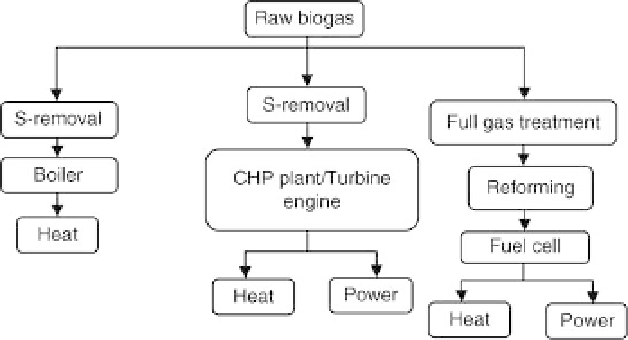Environmental Engineering Reference
In-Depth Information
17.1 Use of biogas for various stationary applications (S-removal
represents removal of sulphur compounds).
H
2
S concentration and H
2
S removal is necessary at concentrations higher
than 1000 ppmv (Chambers and Potter, 2002). In comparison to gas engines,
micro turbines are more resistant to sulphur compounds and lower oxides of
nitrogen, NO
x
(refers to NO and NO
2
)) and carbon monoxide (CO)
emissions. Similarly, extensive biogas cleaning is required for the use of
biogas in fuel cells. Components of concern from an emissions and
equipment safety and maintenance point of view are
.
reduced sulphur compounds (H
2
S, mercaptans (CHaSH), dimethyl
sulphide (CH
3
SCH
3
, DMS), carbonyl sulphide (COS) and carbon
disulphide (CS
2
)) due to their contribution to SO
2
emissions, safety
concerns and corrosion due to formation of sulphuric acid
.
compounds containing nitrogen (N
2
) due to their potential to increase
NO
x
emissions and potential to form nitrous oxide, N
2
O (a greenhouse
gas)
.
chlorinated compounds due to the potential to form dioxins during
combustion
.
siloxanes, which on combustion transform to microcrystalline silicon
dioxide (SiO
2
) and deposit on valves, cylinder walls and liners, causing
abrasion and blockage of pistons, cylinders and valves.
17.2.2 Biogas purification
The typical biogas composition from digesters operating in Europe is
presented in Table 17.1. Depending on the source, biogas mainly contains
45-70% CH
4
, 30-55% CO
2
, 0-2000 ppmv H
2
S and 0-590 ppmv NH
3
(Rasi
et al., 2007; Petersson and Wellinger, 2009). H
2
S concentration is strongly
influenced by the composition of feedstock used for biogas production. The

Search WWH ::

Custom Search